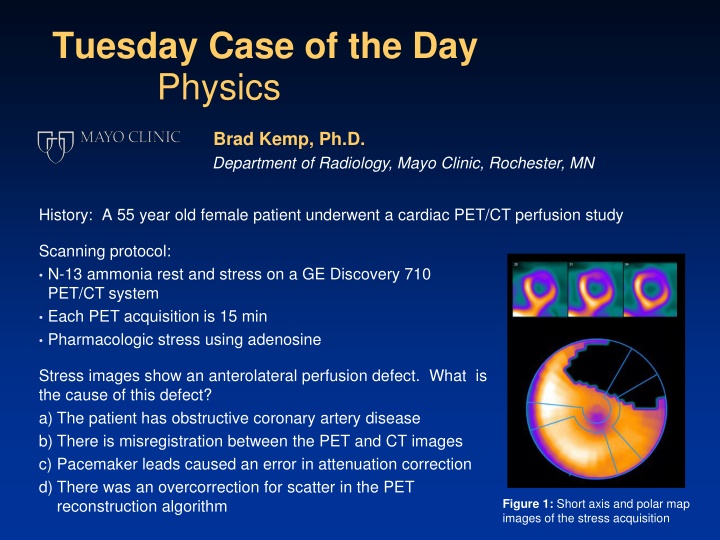
PET/CT Imaging Artifacts: Misregistration Case Study
Explore a case study where misregistration of PET and CT images resulted in an anterior wall perfusion defect in a cardiac PET/CT study. Learn about the causes, consequences, and corrections for this artifact in clinical imaging.
Download Presentation

Please find below an Image/Link to download the presentation.
The content on the website is provided AS IS for your information and personal use only. It may not be sold, licensed, or shared on other websites without obtaining consent from the author. If you encounter any issues during the download, it is possible that the publisher has removed the file from their server.
You are allowed to download the files provided on this website for personal or commercial use, subject to the condition that they are used lawfully. All files are the property of their respective owners.
The content on the website is provided AS IS for your information and personal use only. It may not be sold, licensed, or shared on other websites without obtaining consent from the author.
E N D
Presentation Transcript
Tuesday Case of the Day Physics Brad Kemp, Ph.D. Department of Radiology, Mayo Clinic, Rochester, MN History: A 55 year old female patient underwent a cardiac PET/CT perfusion study Scanning protocol: N-13 ammonia rest and stress on a GE Discovery 710 PET/CT system Each PET acquisition is 15 min Pharmacologic stress using adenosine Stress images show an anterolateral perfusion defect. What is the cause of this defect? a) The patient has obstructive coronary artery disease b) There is misregistration between the PET and CT images c) Pacemaker leads caused an error in attenuation correction d) There was an overcorrection for scatter in the PET reconstruction algorithm Figure 1: Short axis and polar map images of the stress acquisition
Findings:The correct answer is b) This is an artifact caused by misregistration of the PET and CT images. The anterior wall of the myocardium in the PET image is located in the lung in the CT image. See Figure 2. As a result the amount of attenuation is underestimated and a region of hypoperfusion is created. Figure 2: Coronal fused image shows the misregistration of PET and CT images
In order to correct for this artifactual defect the CT AC images must be re-aligned onto the PET images. Next the PET data must be re-reconstructed with the re- aligned CT AC images. Figure 3: Coronal fused image showing the re-aligned PET and CT images Figure 4: Short axis and polar map images of the stress acquisition. Note that the anterolateral defect is not present when the PET and CT images are properly registered.
Discussion: Software that re-aligns the PET and CT images and the re-reconstructs the PET data has been introduced by PET manufacturers in recent years. Generally the software can only correct for gross patient movement and will not correct for local misalignments. Gould reported artifactual PET defects in 103 out of 259 (40%) patients, and the artifacts were moderate to severe in 59 (23%) patients [1]. Moreover, the defects were located in the anterior or lateral areas in 76% of the cases. Kennedy found significant misregistration in 23% of SPECT/CT studies [2]. Hypoperfusion defects were primarily located in the lateral and anterior walls when the myocardium on SPECT overlapped into lung on CT [2]. Rajaram investigated the effect of misregistration on absolute myocardial blood flow measurements [3]. They found that errors in flow measurements were observed throughout the myocardium and were not solely limited to the areas of misregistration.
References: 1. Gould KL, Pan T, Loghin C, et al. Frequent diagnostic errors in cardiac PET/CT due to misregistration of CT attenuation and emission PET images: a definitive analysis of causes, consequences and corrections. J Nucl Med 2007;48:1112:1121. 2. Kennedy JA, Israel O, Frenkel A. Directions and magnitudes of misregistration of CT attenuation-corrected myocardial perfusion studies: incidence, impact on image quality, and guidance for reregistration. J Nucl Med 2009;50:1471-1478. 3. Rajaram M, Tahari AK, Lee AH, et al. Cardiac PET/CT misregistration causes significant changes in estimated myocardial blood flow. J Nucl Med 2013;54:50-54.
